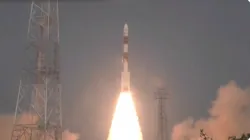ISRO welcomes New Year with launch of XPoSat from Sriharikota to study black holes
ISRO XPoSat launch: It is the first dedicated scientific satellite from ISRO to carry out research in space-based polarisation measurements of X-ray emission from celestial sources. The PSLV-C58 rocket carried primary payload XPoSat and 10 other satellites to be deployed in low earth orbits.

ISRO XPoSat launch Updates: Indian Space Research Organisation (ISRO) kicked off the new year by launching its inaugural X-Ray Polarimeter Satellite (XPoSat), providing valuable insights into celestial entities such as black holes. The satellite was aboard a Polar Satellite Launch Vehicle rocket. This launch follows the accomplishment of the Gaganyaan Test Vehicle D1 mission in October. The 25-hour countdown commenced on Sunday for the lift-off conducted at 9.10 am from the Satish Dhawan Space Centre in Sriharikota, Andhra Pradesh. The PSLV-C58 rocket, in its 60th mission, carried primary payload XPoSat and 10 other satellites to be deployed in low earth orbits. According to ISRO, it is the first dedicated scientific satellite from ISRO to carry out research in space-based polarisation measurements of X-ray emission from celestial sources. The objective of the PSLV-C58 mission includes measuring the polarisation of X-rays in the energy band 8-30 keV emanating from about 50 potential cosmic sources, to carry out long term spectral and temporal studies of cosmic x-ray sources. The X-Ray polarisation serves as a crucial diagnostic tool for examining the radiation mechanism and geometry of celestial sources.
Live updates : ISRO XPoSAT launch
-
12:45 PM (IST) January 01, 2024
ISRO chief terms it 'unique mission': Here's why
On the PSLV-C58 XPoSat mission, ISRO chief S Somanath said it's a unique mission as X-ray Polarimetry is a unique scientific capability we have developed internally building instruments. We want to create 100 scientists who can understand this aspect and then contribute to the knowledge of black holes to the world. "Aditya L1 will reach the L1 point on 6th January and we will do the final manoeuvres then," the ISRO chief added.
-
12:42 PM (IST) January 01, 2024
PSLV vehicle places satellite into orbit of 350 km
After successfully launching the XPoSat satellite into a 650 km circular orbit, the fourth stage of the PSLV rocket has also been launched into a 350 km orbit. Usually, the fourth stage of the rocket used to become useless after launching the satellite and became space debris, but now ISRO scientists have given it the form of a satellite by installing solar panels and batteries in the fourth stage of the rocket. Scientific instruments made by space start-up companies and students are being sent in this satellite.
-
9:41 AM (IST) January 01, 2024
PSLV-C58 vehicle places satellite into intended orbit of 650 km: ISRO
Minutes after the launch of XPoSat, the ISRO stated that the lift-off was normal. PSLV-C58 vehicle placed the satellite precisely into the intended orbit of 650 km with a 6-degree inclination, it added.
-
9:12 AM (IST) January 01, 2024
ISRO successfully launches XPoSat from Sriharikota
ISRO successfully launched the XPoSat from the Satish Dhawan Space Centre in Sriharikota, Andhra Pradesh. ISRO's maiden X-Ray Polarimeter Satellite would offer insights into celestial objects like black holes.
-
9:02 AM (IST) January 01, 2024
PSLV-DL variant has lift-off mass of 260 tonnes
The rocket that will fly is the PSLV-DL variant which has a lift-off mass of 260 tonnes. The fourth stage is configured as a 3-axis stabilized Orbital platform for conducting experiments. The payloads are Radiation Shielding Experiment Module by TakeMe2Space, Women Engineered Satellite by LBS Institute of Technology for Women, BeliefSat (an amateur radio satellite) built by KJ Somaiya Institute of Technology, Green Impulse Transmitter by Inspecity Space Labs Pvt Ltd, LEATTD -- Launching Expeditions for Aspiring Technologies Technology Demonstrator by Dhruva Space Pvt Ltd, RUDRA 0.3HPGP and ARKA 200 developed by Bellatrix Aerospace Pvt Ltd, Dust Experiment (DEX) built by PRL, ISRO and Fuel Cell Power System and Si-based High Energy cell built by Vikram Sarabhai Space Centre.
-
9:00 AM (IST) January 01, 2024
XPoSat mission's life is about of 5 years
The primary payload of XPoSat is POLIX (Polarimeter Instrument in X-Rays) which is designed to measure polarimetry parameters by Raman Research Institute and XSPECT (X-ray Spectroscopy and Timing) built by the U R Rao Satellite Centre, Bengaluru. The Mission life is about 5 years. The space-based study of X-Ray polarisation is gaining utmost importance internationally, and in this context, the XPoSat mission would play a significant role. XPoSat mission's life is about of 5 years
-
8:32 AM (IST) January 01, 2024
PSLV rocket to deploy primary satellite into a 650 km Low Earth Orbit
The 44.4-meter-tall PSLV rocket would first deploy the primary satellite into a 650 km Low Earth Orbit around 21 minutes after lift-off and later the scientists would bring the satellite to a lower altitude of about 350 km by restarting the fourth stage of the vehicle, for conducting the PSLV Orbital Experimental Module-3 (POEM-3) experiment. It may be recalled that the space agency conducted a similar scientific experiment using POEM-2 in the PSLV-C55 mission in April 2023.
-
8:24 AM (IST) January 01, 2024
What are objectives of this mission?
The objectives of this mission are to measure polarisation of X-rays in the energy band 8-30keV emanating from about 50 potential cosmic sources through Thomson Scattering by POLIX payload; to carry out long term spectral and temporal studies of cosmic X-ray sources in the energy band 0.8-15keV by XSPECT payload; and to carry out polarisation and spectroscopic measurements of X-ray emissions from cosmic sources by POLIX and XSPECT payloads respectively, in the common energy band.
